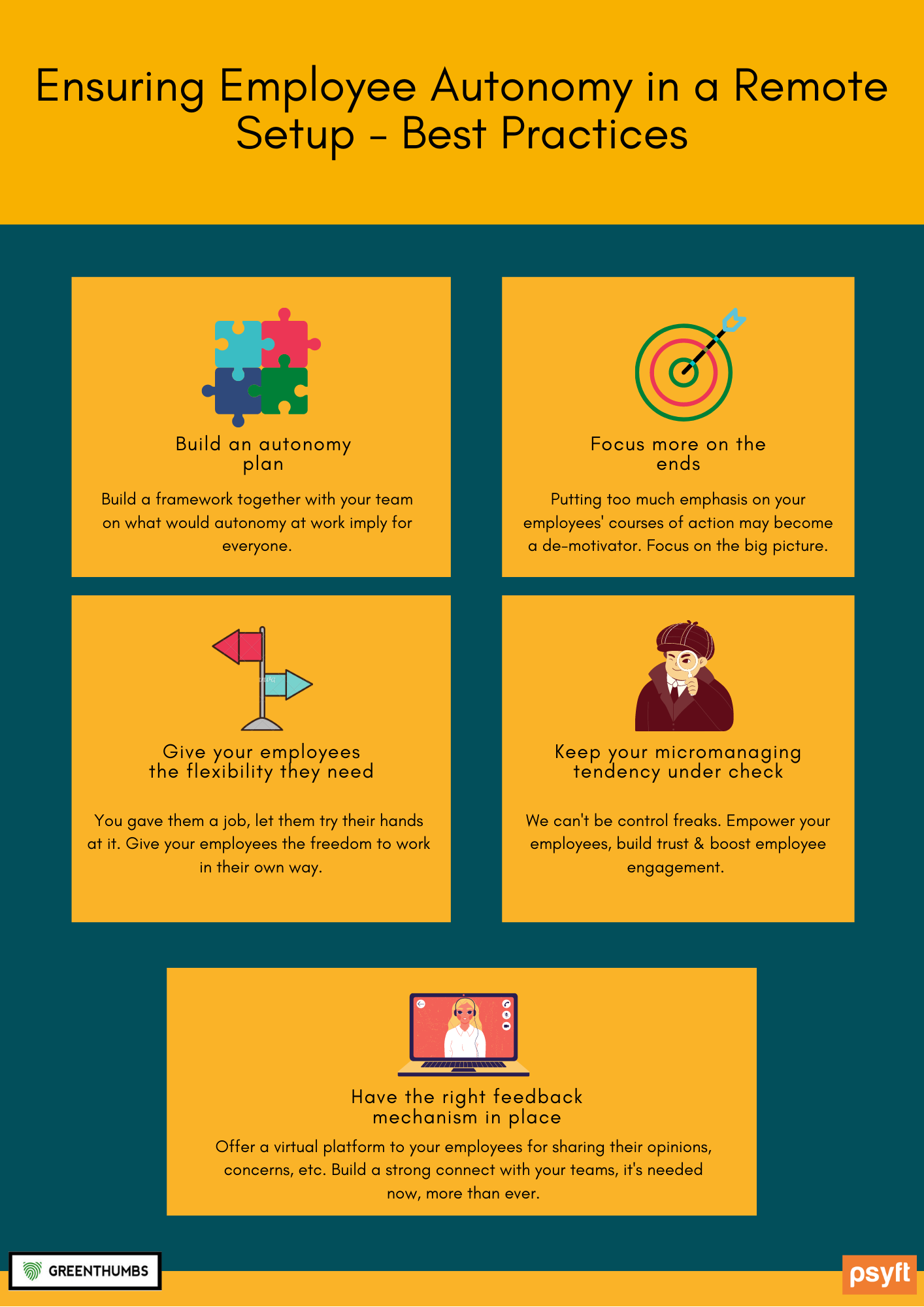Blogs
Your source to the latest insights on what's trending in the HR arena - Recruitment, Talent Assessments, Employee Surveys and Training.

Ensuring Employee Autonomy in a Remote Setup – Best Practices
Among the various challenges that organizations are facing while trying to cope with COVID 19 times, offering autonomy in a remote workplace is a crucial factor that needs to be paid attention to. Since managers aren’t working with their teams in close physical proximities anymore, and everything is a virtual reality now, the urge to micromanage tends to become more prominent, voluntarily or involuntarily.
Having said that, leaders who are able to overcome this urge and offer more freedom and autonomy to their employees, in the current remote work scenario, are experiencing a smoother run of businesses, rise in employee engagement and productivity levels.
What does employee autonomy mean?
Employee autonomy refers to the freedom an employee gets, to decide how (including when and where) does he/she go about doing their work. Simply put, it’s about the control and discretion employees have while doing their work.
Providing employee autonomy means allowing your employees to shape their work environment themselves in a way that allows them to perform to the best of their ability. Some believe that autonomy is about working in isolation, not really, it’s about doing what you want, the way you want to do it.
Autonomy at workplace is based on elements like – mutual trust, flexibility, self-discipline, reliability, responsibility, accountability. Truly granting your employees the freedom they need at work, entrusting them with responsibility, empowering them with accountability, and making them a part of the decision making process – that’s employee autonomy.
Why is employee autonomy so crucial?
Let’s see how employee autonomy plays a crucial role –
- Elevated Motivation Levels - The more control we have, the more motivated we become to succeed. Employees offered greater autonomy feel their managers trust them, they become more confident and motivated to put in extra efforts to excel.
- Healthier Employees – Mental well-being is perhaps one of the most pressing needs organizations ought to focus on these days. A research suggests that flexibility at work promotes personnel well-being and a more healthier behavior from employees - employees sleep better, have better energy levels, and less susceptible to burnout and psychological distress, they are also able to balance work and personal life better.
- Better Growth - Giving freedom to employees means giving them the opportunity to learn, grow and develop in their role. Greater autonomy at work makes employees think out of the box, take better decisions, learn new skills, as no one is holding them back from exploring better ways of doing things and gaining success. You would surely want a growing team on your side.
- Builds Engagement - Autonomy leverages employee commitment. A study conducted at the University of Melbourne stated that employees who were given more control over areas such as schedule, workflow, and input on strategy were more, engaged and loyal. Also, the study said that when employees were given more autonomy, they were more likely to be self-driven.
Best Practices to ensure Employee Autonomy
Set up an autonomy plan
Having trouble in figuring out to go about giving and managing autonomy? Here’s what you should do – set up a plan. Build a framework, together with your teams on guidelines about what autonomy at work will imply for everyone.
These guidelines could be around how and when to share updates on projects, what matters are at the discretion of the teams and what need to be brought to their managers’ attention, how will the decision making process work, etc.
Drafting an autonomy plan will help keep the entire team aligned on how to run business affairs and mitigate any sort of chaos or confusion that may come up, especially in the current remote work scenario.
Focus more on the ends
You have assigned your team a task, now let them try their hands at it, come up with the best way to achieve the goal and put in their efforts towards it. Many companies, especially now, when we have gone all remote and virtual, focus too much on tracking employee activities and measuring input at every level. Such companies believe that this forms the basis for measuring employee performance.
There’s no denying the fact that all companies have certain metrics set which need to be accomplished. There are also tools - like Hubstaff, Workpuls, DeskTime, etc. that allow organisations to track work in real-time, however, the key lies in using these in a balanced way.
Putting too much emphasis on how your employees are working and their courses of action can prove to be a major de-motivator. Focus on the goals that need to be achieved for business success, touch base with your people when it’s actually required. You need to demonstrate your trust in your team now, more than ever.
Give your employees the flexibility they need
You can’t be dictating your employees all the time. They were brought onboard for a job, let them perform their role. Employee autonomy is about providing flexibility, mutually setting targets, agreeing on deliverables with your employees and then giving them the freedom to work in their own way.
40% of employees feel that the greatest benefit of remote work is the flexible schedule.
All employees thrive in environments where there’s trust, and flexibility at work is offered. A flexible work environment not only brings along smoother business transition but also adds value to the employer brand among future hires.
14. 69% of the millennial population would give up other work benefits for a more flexible working space.
Keep your micromanaging tendency under check
We cannot be control freaks, there’s as it is a lot going on in the lives of people working remotely – balance work and home, look after family, manage household chores and much more; let’s not add up to the stress.
Try and curb your urge to micromanage, especially when not required at all. Remote work offers you the opportunity to empower your employees, build trust and boost employee satisfaction and engagement levels, embrace this opportunity.
The aim is not to leave checking up on your employees completely and become absolutely undemanding or casual about work, but to manage cautiously. Run a check when it’s needed not whenever you want to. Excessive micromanagement may get distracting for employees and lower their productivity levels too.
“A study stated that employees were 26% more satisfied with their work when they held a position of power.”
Have the right feedback mechanism in place
Even with autonomy and flexibility offered, employees will still have stuff to discuss with managers or would like to just run something quickly by their leaders.
Managers need to provide a virtual platform to their employees, where they can share their feedback, opinions, and even concerns, you need to be available to your teams when needed. Sometimes such feedback helps in realizing certain loopholes that may exist in the autonomy policy in place and revamping these, for the better.
There are a number of tools that make this a lot easier and hassle free - instant feedback applications where employees can simply share feedback on tasks, projects, etc. even through a simple chat.
This quickens the whole employee feedback handling process and strengthens connect among teams, a factor that’s a must these days.
Conclusion
By offering autonomy to employees, we certainly don’t mean leave everything up to them and have no say at all – that’s a recipe for chaos. Every business needs to build a work culture based on its value system, this gives a sense direction and purpose to employees and they stay aligned with the overall organizational vision.
Once the work environment is in line with the overall vision and the KPIs have been set, etc., employees should be able to take ownership of their roles, their responsibilities and work towards getting the job done.
The key is –
a. Not to micromanage your employees
b. To continue to support, guide and mentor your employees
c. To check in on them, but not to go overboard with it.
d. To strike a balance.
FAQs
1 : What is employee autonomy in a remote setup?
Answer : Employee autonomy in a remote setup refers to the freedom given to employees to decide how, when, and where they perform their work. It allows employees to control and make decisions about their work environment.
2 : Why is employee autonomy important?
Answer : Employee autonomy is crucial because it leads to elevated motivation levels, promotes healthier employees, encourages better growth, and builds engagement. It enhances trust, confidence, and overall well-being among employees.
3 : What are some best practices for ensuring employee autonomy in a remote work scenario?
Answer : Best practices include setting up an autonomy plan, focusing on goals rather than micromanaging, providing flexibility, keeping micromanagement in check, and having the right feedback mechanism in place.
4 : How can organizations strike a balance between autonomy and control?
Answer : Organizations can strike a balance by defining clear guidelines for autonomy, emphasizing goal-oriented performance, offering flexibility, limiting micromanagement, and maintaining open communication channels for feedback.
5 : What is the key takeaway regarding employee autonomy?
Answer : The key takeaway is that by offering autonomy, organizations can empower their employees, enhance engagement, and promote a healthier work culture. Striking a balance between autonomy and control is essential for success in a remote work environment.
Recent Articles
News Center


- India Today - 7 reasons companies ask for psychometric tests
- Business World - AI - The New Secret Sauce in Psychometric Assessments
- DNA - HR Trends for 2018
- The Hindu - Psychometric Assessment a "game changer" in hiring
- Entrepreneur - 9 ways to promote actionable feedback at organisations
- Human Capital - Looking Beyond Performance Appraisals
Top Trending Pages
- Best Employee Engagement Survey Company
- Executive Search | Online Assessments & Surveys
- Top Personality Assessment Providers in India
- Talent Search | HR Consulting | Recruitment
- Manager Effectiveness Survey
- What is Training Needs Analysis (TNA)? - Meaning & Benefits
- GreenThumbs: One of the Best Executive Search Firms in India
- Know Your Employee Net Promoter Score
- Employee Onboarding Survey
- 360 Degree Feedback | FAQs
